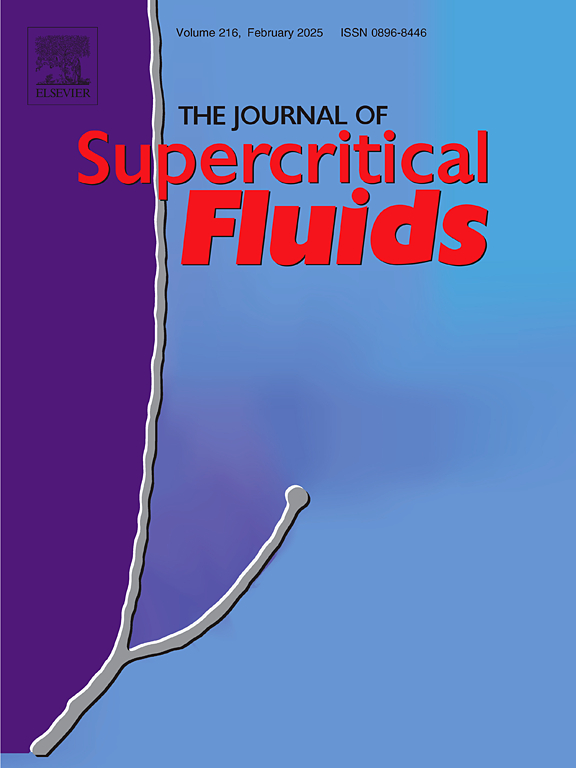Measurement of key critical parameters for binary mixture of carbon dioxide (CO2) + dimethyl ether (DME) and modification of the CO2 + hydrocarbon (HC) prediction model
IF 4.4
3区 工程技术
Q2 CHEMISTRY, PHYSICAL
引用次数: 0
Abstract
The critical parameters of carbon dioxide (CO2) + dimethyl ether binary mixture, including critical temperature and pressure, have been determined by variable-volume view-cell method in this study. The critical point is determined by observing the disappearance and reappearance of the vapor-liquid meniscus at the center of the sapphire viewport. The extended uncertainties of mixture composition, critical temperature, and critical pressure are less than 0.00023, 0.5 K, 0.03 MPa (k = 2, 0.95 confidence level), respectively. The experimental results are compared with predictions from the Peng-Robinson equation of state, the Modified Extended Chueh–Prausnitz (MECP) method, the Helmholtz energy equation of state, as well as with relevant data available in the literature. In addition, the Redlich-Kister equations are employed to correlate the experimental data, demonstrating excellent agreement with the average absolute relative deviation of 0.370 % for critical temperature and 0.252 % for critical pressure. Finally, the empirical coefficients of the MECP method are refined through correlating with experimental data of CO2 + hydrocarbon mixture, thereby enhancing prediction accuracy for the critical properties of such mixture.
二氧化碳(CO2) +二甲醚(DME)二元混合物关键参数的测定及CO2 +烃(HC)预测模型的改进
本文采用变体积视池法测定了二氧化碳(CO2) + 二甲醚二元混合物的临界温度和临界压力。临界点是通过观察蓝宝石视口中心汽液半月板的消失和再现来确定的。混合物组成、临界温度和临界压力的扩展不确定度分别小于0.00023、0.5 K、0.03 MPa (K = 2,置信水平为0.95)。实验结果与Peng-Robinson状态方程、修正扩展Chueh-Prausnitz (MECP)方法、Helmholtz能量状态方程的预测结果以及文献中的相关数据进行了比较。此外,采用Redlich-Kister方程对实验数据进行了关联,结果与临界温度的平均绝对相对偏差0.370 %和临界压力的平均绝对相对偏差0.252 %非常吻合。最后,通过与CO2 + 混合烃实验数据的关联,对MECP方法的经验系数进行了细化,从而提高了混合烃临界性质的预测精度。
本文章由计算机程序翻译,如有差异,请以英文原文为准。
求助全文
约1分钟内获得全文
求助全文
来源期刊

Journal of Supercritical Fluids
工程技术-工程:化工
CiteScore
7.60
自引率
10.30%
发文量
236
审稿时长
56 days
期刊介绍:
The Journal of Supercritical Fluids is an international journal devoted to the fundamental and applied aspects of supercritical fluids and processes. Its aim is to provide a focused platform for academic and industrial researchers to report their findings and to have ready access to the advances in this rapidly growing field. Its coverage is multidisciplinary and includes both basic and applied topics.
Thermodynamics and phase equilibria, reaction kinetics and rate processes, thermal and transport properties, and all topics related to processing such as separations (extraction, fractionation, purification, chromatography) nucleation and impregnation are within the scope. Accounts of specific engineering applications such as those encountered in food, fuel, natural products, minerals, pharmaceuticals and polymer industries are included. Topics related to high pressure equipment design, analytical techniques, sensors, and process control methodologies are also within the scope of the journal.
 求助内容:
求助内容: 应助结果提醒方式:
应助结果提醒方式:


